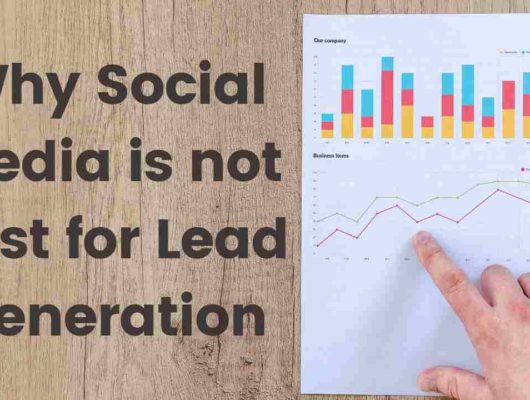Introduction
B2B lead generation is all about balancing lead quality, lead volume and lead cost. As a B2B business you need to determine what works best for your business goals.
Some businesses prioritize on lead volume and to achieve this goal they have large sales teams, elaborate lead nurturing strategy and active call centres. This helps them to collect large number of contact that are transferred into the sales funnel. The budget is mostly lax, as long as the lead cost is kept lower.
However, the goal for B2B companies is primarily on lead quality. The budget is more regulated, and efforts go towards lead qualification, prospect outreach and lead nurturing. The goal for B2B firms is to acquire good quality leads that have high chances of converting into customers.
Definition of a High-Quality Lead
A high-quality lead is a prospect that has greater chances of converting into a client. There are several metrics that can be used to assess a high-quality lead. Some key scoring metrics include company profile, matches your buyer persona, engagement with your channels, ability to purchase your product and interest in your product or service.
Lead Quality and its Importance for B2B Businesses
A B2B business relies on a steady customer base to keep their business running. Your potential customers start as prospects or leads, that are then nurtured by your sales team and then are converted into paying customers.
A good quality lead ensures that your efforts to nurture them do not go to waste. A small amount of good quality leads also helps to avoid bottlenecks in the sales funnel (something that happens when too many incoming leads overwhelm the sales funnel).
Good quality leads ensure that there is balance between the sales and marketing departments of your company and the process of lead generation is optimized.
When you generate high quality leads, there are greater chances that this lead will become a customer in the future, so your company resources are not wasted following cold leads. This in turn leads to greater revenue for your business.
You know the pain points of a high-quality lead and they are willing to listen to what solution that you have to offer. Therefore, with proper nurturing techniques, you will ensure conversion.
In this article we will discuss seven effective ways to improve lead quality for your B2B company.
1. Identify your target audience
You can improve your lead quality by understanding your target audience and in the process defining your audience better.
One of the most common reasons that lead generation campaigns are unsuccessful is because the companies fail to identify their target audience. The campaigns are targeted to everyone in hopes that someone will come across your page or website and will contact you. While this method may generate lots of leads, but they will not be of good quality.
A good strategy would be to take time to understand your potential customers and draft buyer personas based off of them. Identify their pain points and how your service or product can help them.
Take into account how your buyer makes a decision. In a B2B environment, your buyer will take some time and convincing to make a final decision.
Once your buyer personas are developed you can easily apply audience segmentation in your marketing campaigns to deliver high quality leads.
Accurate buyer personas require technical knowledge and expertise to develop. We can help with that, click here to book a meeting today.
2. Create a Lead Scoring System for your MQL and SQL
A lead scoring system can streamline your lead generation process by helping your sales and marketing team to effectively grade incoming leads. Only leads that score high (also known as qualified lead) will be pushed down the sales funnel.
Before going into detail about creating a lead scoring system, let’s first discuss what an MQL and SQL are:
What is an MQL (Marketing Qualified Lead)
An MQL is a lead that has been evaluated by the marketing department of a company and satisfies pre-established criteria. The sales and marketing departments of a business, along with other stakeholders, first agree on the criteria. If an MQL is nurtured properly, they could become a customer based on the established criteria. At this point the ownership of a lead would transfer from the marketing team to the sales team once it had been classified as an MQL.
What is an SQL (Sales Qualified Lead)
A lead is considered to be “sales qualified” if the sales department of a company has evaluated it and claims that it passes the predetermined criteria. The sales and marketing departments of a business, along with other stakeholders, first agree on the criteria. Using the established criteria as a guide, SQLs have higher chances of becoming a client. They have expressed interest in your goods and services, therefore they’re likely to be open to speaking with the sales staff or perhaps looking forward to it.

Free Scorecard – Get Personalized Lead Quality Improvement Advice (with actionable tips) in 5 mins.
How to create a Lead Scoring system for MQL and SQL
As a B2B business, you will need to tailor a customized lead scoring system based on your business type, industry, type of service they need, size of organization and other factors that may make a lead important to you. You should also take into account whether the lead has the capacity to buy your products or subscribe to your services. Here are the steps to create a scoring system for a qualified lead. These steps can be tailored to create a scoring system for either MQL or SQL:
- Start with buyer personas. Buyer personas will help define your target audience.
- Observe online behaviour. By carefully observing behavioural touchpoints you will be able to see which type of behaviour leads to buying. You can look for metrics like time spent on website or social pages, email click through rate and subscription to your newsletter.
- Choose final attributes for scoring. Select which attributes you would like to include in the final scoring system.
- Allocate a score to each attribute. You can choose which of the attributes will have a higher score and which will have a lower one.
- Consider automating the process. You can score leads as soon as they are generated. Certain software can be used to setup parameters and divide leads based on their score.
3. Employ Targeted Marketing Techniques
There are several way to reach your target audience and generate high quality leads in the process. By dividing your efforts equally between generating organic traffic and using paid advertising you can create a good flow of quality leads.
Want to use targeted marketing techniques to improve your lead quality? Talk to an expert today, click here to book a meeting with us.
Use Different Marketing Techniques to Generate MQL
When pursuing high quality leads, it’s a good idea to generate an MQL through your lead scoring system. This ensures that the leads are qualified upon generation and directed towards the marketing department for nurturing. A qualified marketing lead can be generated through targeted marketing techniques such as defining audience, audience segmentation and running paid ad campaigns based off these parameters.
Generate Content based on your Buyers Journey
In short, you should make content specific to each marketing funnel stage. Leads that are the top of the funnel (TOFU), content should build awareness e.g., guides. Middle of the Funnel (MOFU) Leads can have content that is more sales oriented like a blog talking about your services. While, Leads at the bottom of the funnel (BOFU) are ready to make a funnel and they should be shown content that closes the deal, for example a webpage on how to setup a meeting or how to contact your sales team.
Separate Leads as Soon as they are Generated
Lead scoring automation can help you separate leads into high, medium and low priority as soon as they are generated. This way only high-quality leads are given preference and are guided through the sales funnel. Finally, the sales team can rate the lead as an SQL for further nurturing.
4. Utilize lead capture forms and landing pages
Many social media platforms offer lead capture forms, that can be incorporated into your paid ad campaigns. This strategy would include creating an Ad campaign that encourages your target audience to fill a lead generation form in return for an incentive. An incentive could be an eBook, guide, or an offer.
Similarly, you can create Ad campaigns that take the user to your website’s landing page where they can sign-up or subscribe to your newsletter. This way you will have superior quality leads.
In both the afore mentioned strategies, it is important to create lead magnets to encourage conversion of website visitors to high quality leads. A lead magnet can be an incentive, eBook, downloadable content, or subscription to your newsletter.
5. Align your Marketing and Sales Team
The marketing and sales team both have their roles to play in the lead generation process. Therefore, it is important to reduce miscommunication between the sales and marketing team. This ensures that the lead generation process is more streamlined and only high-quality leads are going through the sales funnel.
Use the lead scoring system that you developed to develop an MQL that then gets passed down to the sales team, where they can qualify it as an SQL. A lead scoring system can reduce discrepancy and gaps between MQLs and SQLs. Moreover, your sales team will spend more time with qualified leads, ensuring that they convert into customers.
Encourage communication between the sales and marketing team. So, if in the future there are any changes to the scoring system, everyone is informed timely. Better communication means that the marketing will be better at recognizing what a qualified lead looks like to your sales team.
6. Don’t Ignore the Analytics Data
Analytics data is the information you receive after you successfully run an Ad campaign. Online marketing campaigns generally produce real time data such as click through rate (CTR), ROI, conversions, clicks and impressions.
Analytics data can be important in optimizing your Ad strategy, but it can also improve your lead quality in the longer run. Analytics data can reveal what your users like to interact with, what type of content they like to download, or which type of content encourages them to sign-up for your lead generation form.
Repurposing content that encourages targeted users to sign-up your lead gen form can generate greater high quality. Alternatively, you can offer greater incentives (or lead magnet) to attract a higher quality lead.
Conclusion
Lead quality, lead volume, and lead cost must all be balanced in B2B lead generation. The goal for B2B companies is to acquire high-quality leads that are likely to convert into customers.
A high-quality lead is a prospect that is more likely to become a client. When you generate high-quality leads, there is a greater chance that this lead will convert into a customer in the future, preventing your company’s resources from being wasted on cold leads. This, in turn, leads to increased revenue for your company.
You can improve the quality of your leads by better understanding and defining your target audience. A lead scoring system can help your sales and marketing teams effectively grade incoming leads, consequently streamlining your lead generation process. Lead scoring has the potential to save you both time and money in the long run.
You can reach your target audience by equally dividing your efforts between generating organic traffic and using paid advertising to generate a steady flow of quality leads.
Many social media platforms give you the option to use lead capture forms that can be integrated into paid ad campaigns. This strategy entails developing a lead magnet and marketing it via paid ad campaigns.
It is critical to strengthen communication between the sales and marketing teams. This ensures that the lead generation process is more efficient and that only high-quality leads enter the sales funnel.
Analytics data can help you optimize your Ad strategy, but it can also help you improve lead quality in the long run.
Thinking about improving your lead quality and optimizing your lead generation process? We can help, book a meeting with us today, click here.
keywords
Lead Qualification best practices, B2b lead sources, B2b lead nurturing email examples






